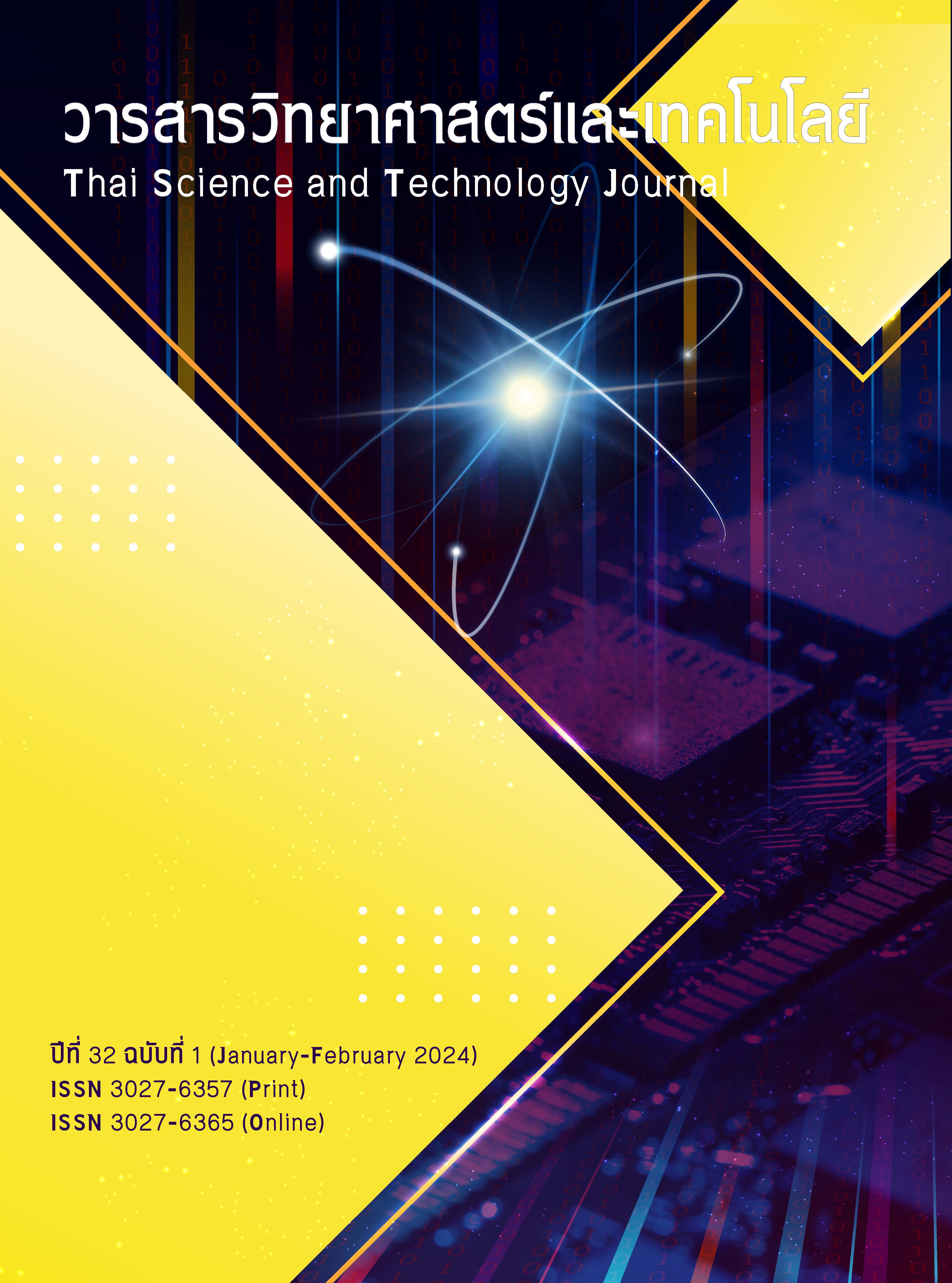The Anthocyanin Extract from Orchid Flower Used as an Acid-base Naked-eye Sensor
Main Article Content
Abstract
In this research, an acid-base detector was created using anthocyanin extract from orchid flowers. The anthocyanin was easily extracted in an aqueous solution. The results indicate that the cyanidin-3-glucoside content of the extract was 7.91+0.72 mg/l. The pH of the extract was 5.03±0.05. The total soluble solids were 2.69±0.63. The color changed with pH 2.0-10.0 buffer solution showing a color change from red to green when tested from acid to base. The extract was assigned as a probe by impregnating it on cellulose paper. The paper detector can change the color for naked-eye detection. When tested with pH buffer solutions ranging from 2.0 to 10.0, the total color difference (∆E) was greater than 5. Additionally, when comparing the pH of the solution from cellulose paper with the pH meter and universal indicator paper, similar results were obtained. Therefore, anthocyanin extracts from orchids can be used as a pH-base tester.
Article Details
References
Arusa, C., (2011). Extraction and analysis of Anthocyanin. SWUJournal. 3(6): 26-36. (in Thai)
Thanikan, S., Kanokwan, S., Jidapa, J., Jutima, S., Petcharat, S., Yosita Y., Sumonmarn, C., (2019). Application of Natural Reagent from Orchid Flower as Indicator for Volumetric Acid-base Titration. TSTJ. 28(9): 1545-1557. (in Thai)
Mayarachat, C., Sanoe, C., (2021) Frabication of simple paper-based indicator for using in acid-base learning. J. sci and sci ed. 3(1): 61-72. (in Thai)
Rattana, W., Khwankamol, C., Chalermporn, T., (2016). Colored plants used as natural indicators. Rajabhat J. Sci. Humanit. Soc. Sci. 17(1): 74-83. (in Thai)
Chalermporn, T., Piyawat, K., (2015). Acid-base titration by using Butterfly pea extract as indicator. Rajabhat J. Sci. Humanit. Soc. Sci. 16(2): 156-166.
Fansen, Z., Yanqi, Y., Jingna, L., Peng, Fei., (2023). Intelligent pH indicator composite film based on pectin/chitosan incorporated with black rice anthocyanins for meat freshness monitoring. Food Chem :X. 17: 1-10.
Kana, H. E., Wen, X. L. F., Joseph, M. V., Kobun, R., Koh, W. Y., (2022). Synthesis and Physicochemical Characterization of Polymer Film-Based Anthocyanin and Starch. Biosensors. 12 (211): 1-15.
Xiaodong, Z., Jiyong, S., Xiaobo, Z., Sheng, W., Caiping, J., (2017). Novel colorimetric films based on starch/polyvinyl alcohol incorporated with roselle anthocyanins for fish freshness monitoring. Food Hydrocolloids. 69: 308-317.
Inyoung, C., Jun, Y. L., Monique, L., Jaejoon, H., (2017). Intelligent pH indicator film composed of agar/potato starch and anthocyanin extracts from purple sweet potato. Food Chem. 218: 122-128.
Simin, P., Hadi, A., Saeed, M., Sajad, P., Ehsan, P., (2017). Development of a colorimetric pH indicator based on bacterialcellulose nanofibers and red cabbage (Brassica oleraceae) extract. Carbohydr. Polym. 156: 193-201.
Fahimeh, E. T., Mehran, M., Hossein, T., Mehrdad, F., Parya, E., Bambang, K., (2019). Cellulose/chitosan pH-responsive indicator incorporated with carrot anthocyanins for intelligent food packaging. Int. J. Biol. Macromol. 136: 920-926.
Luciana, P., Taiane, C. M., Vania, Z. P., Jessica, F. H., Nathan, L. V., Loong-Tak, L., Alvaro, R. G. D., Elessandra, da R. Z., (2017). pH-sensitive films containing anthocyanins extracted from black bean seed coat and red cabbage. LWT- Food Sci. Technol. 80: 492-500.
Samart, S., Phunsiri, S., Wirongrong, T., Saroat, R., Pimonpan, K., Thomas, K., Frédéric, D., Pascal, D., (2021). Using Anthocyanin Extracts from Butterfly Pea as pH Indicator for Intelligent Gelatin Film and Methylcellulose Film. Curr. Appl. Sci. Technol. 21(40): 652-661.
Jungmin, L., Robert, D., Robert Ronald, E. W.,2005, Determination of total monomeric anthocyanin pigment content of fruit juices, beverages, natural colorants, and wines by the pH differential method: Collaborative Study, J. AOAC Int. 88(5): 1268-1278.
Thanikan, S., Petcharat, S., Sumonmarn, C., 2017. Use of Natural Pigment from Orchid as a Reagent for Quantitative Analysis of Ammonia in Chemical Fertilizers, BUSCIJ. Special Volume 2017: 366-376. (in Thai)
Bumrungrat, R.,a Thongchai, S., Pitiporn, R., Sumaporn K., .2018, Determination of water activity, total soluble solids and moisture,sucrose, glucose and fructose contents in osmotically dehydratedpapaya using near-infrared spectroscopy, Kasetsart J.: Nat. Sci. 52:557-564.
Anthony, A., Vasil, G., Joel, O., Bobby, P. and Violeta, T., (2013). Production of Anthocyanins in Grape Cell Cultures: A Potential Source of Raw Material for Pharmaceutical, Food, and Cosmetic Industries. The Mediterranean Genetic Code. InTech. 247-287.


